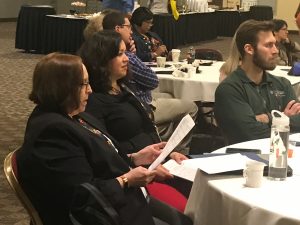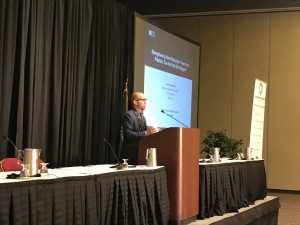By Mark Hansel
NKyTribune managing editor
A crowd of more than 500 came from throughout the Commonwealth to Covington Tuesday for the 2019 Kentucky Harm Reduction Summit.
The list of speakers included Cabinet for Health and Family Services (CHFS) Secretary Adam Meier, Department for Public Health (DPH) Commissioner Jeff Howard and other public health representatives, harm reduction experts and response partners.

Department for Public Health (DPH) Commissioner Dr. Jeff Howard speaks about harm reduction efforts at the state level at Tuesday’s summit (photos by Mark Hansel)
The informational summit held at the Northern Kentucky Convention Center brought together healthcare professionals, law enforcement, state and local community and government leaders, community mental health centers, first responders and numerous service organizations from across the state.
Harm reduction can be hard to define, but it is essentially a focus on strategies and ideas designed to reduce negative consequences associated with illegal drug use.
It is also an effort to encourage acceptance of the belief that using drugs does not preclude people from the same rights, and social acceptance, afforded all other members of society.
The group gathered to spotlight the current harm reduction strategies at work in the state and to discuss work still needed at the heart of harm reduction and drug policy.
District Director of Health Dr. Lynn Saddler, with the Northern Kentucky Health Department said it was “awesome” to have the statewide Harm Reduction Summit held in the region.
“We’ve got law enforcement, we’ve got public health, we’ve got all kinds of folks who are here today learning about what is the latest and greatest information on harm reduction,” Saddler said. “All of us can take information back and make our programs, including our syringe exchange programs even better and more effective and helping that vulnerable population of people who have substance abuse disorders in our communities.

District Director of Health Dr. Lynn Saddler (L), from the Northern Kentucky Health Department, prepares for an afternoon breakout session. Saddler said the Harm Reduction Summit allowed those in attendance to take best practices back to their communities for possible implementation.
Meier said getting the perspective of so many different groups and individuals focused on harm reduction helps provide a complete picture.
“Our discussions here today spotlight the valuable work that has been done in our local communities and allowed us to define further work needed to better understand the issues at hand surrounding harm reduction in Kentucky,” Meier said.
Topics discussed at the harm reduction summit included: Law Enforcement Support of Harm Reduction; Prevention and Harm Reduction; Community Planning for Harm Reduction; Harm Reduction 101; Harm Reduction Leadership; and Harm Reduction and Families in Recovery.
“This summit focuses on a number of perspectives from prevention to recovery,” said Howard. “It also provides an opportunity to examine and discuss harm reduction principles including participant-centered services, sociocultural factors, and health and dignity.”
The keynote speaker was Jon Zibbell, senior public health analyst with RTI International.
RTI International is an independent, North Carolina-based nonprofit research institute dedicated to improving the human condition.

Jon Zibbell, senior public health analyst with RTI International, was the morning keynote at the Summit. He said one of the challenges faces those focused on harm reduction is that organizations that share common goals disagree on implementation strategies.
Zibbell provided statistics showing how the scourge of addiction that has gripped our region, the state and the nation, began with the abuse of prescription opioids. The problem increased and eventually exploded with the widespread use of heroin, and later fentanyl and carfentanyl. Intravenous injection as the method of delivery created a serious health threat to users and the public at-large.
Zibbell said one of the challenges of dealing with harm reduction is that groups with common goals don’t always agree on the best way to achieve them.
He pointed to the way syringe exchange programs are often viewed differently by public health officials and law enforcement as an example.
“Once HIV was identified as a blood-borne virus, transmitted by sharing needles, needle exchange was immediately caught at the intersection of two contradictory policy logics,” Zibbell said. “While law enforcement and public health are both state institutions, they each had their own ways for how they understood illegal drug use and related harms.”
Law enforcement officials, Zibbell says, often see syringe exchange as providing drug users with the tools needed to feed their habit, and that is contrary to their objectives.
“Law enforcement is charged with fighting illegal drug use through drug control strategies and interdiction – getting stuff off the street – but also incarceration and rehabilitation,” Zibbell said. “Law enforcement regulates the possession and sale of syringes by legally classifying non-medical use as paraphernalia, to ensure needles are not readily available. Of course, legislation does that, law enforcement just enforces the law.”
Public health officials see syringe exchange as a way to provide safe needles to IV drug users and offer access to treatment.
“Public health is charged with protecting the health of society by rendering illegal drug use epidemiologically harmless,” Zibbell said. “Liberalization of needles by public health is seen as a strategy to protect society from infectious disease.”

The DPH statewide Harm Reduction Mobile Unit was onsite at the Summit to provide training and distribution of naloxone to those interested.
Both groups have the common goal of eliminating illegal, intravenous drug use, but don’t see eye-to-eye on the best way to accomplish that, while also working to ensure the health of the general public.
The morning session included a series of speakers who focused on a variety of topics, including what the state is doing to advocate for harm reduction.
The afternoon program featured a series of breakout sessions focused on identifying harm reduction and strategies that can be employed by agencies, families and community stakeholders.
Saddler led a session focused on advocating for harm reduction across a diverse district.
“I will talk about a brief history of the opioid crisis in Northern Kentucky and the way that we advocated for syringe exchange,” Saddler said. “Northern Kentucky has the urban core, suburbia and rural areas, and it’s very different how you work with the different communities to get the support for those programs.”
The new DPH statewide Harm Reduction Mobile Unit was also onsite and available for tours during the day to provide training and distribution of naloxone to those interested.
Additional information on the summit is available here.
Contact Mark Hansel at mark.hansel@nkytrib.com
















